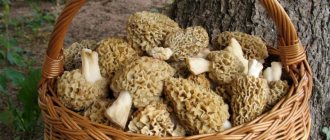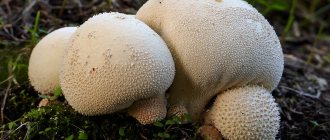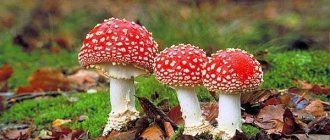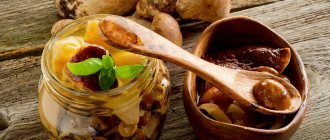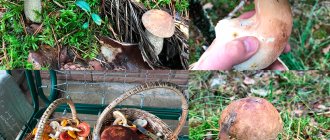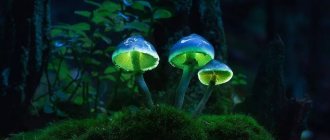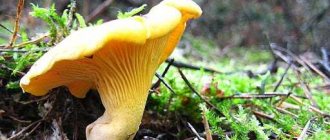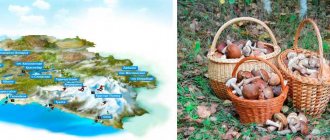Small spines can be seen on the surface of certain types of mushrooms: as a rule, hedgehogs and puffballs most often have similar spiny hymenophores. Most of these fruiting bodies are edible at a young age and can be subjected to any type of culinary processing. If you collect prickly mushrooms in late autumn, you can eat them only after a long boil.
Answers to the question Thorn mushroom 6 letters
- Honey fungus - A popular or unsystematic name for a group of mushrooms belonging to different genera and families. The name comes from the characteristic habitat of these mushrooms: most of them grow on living and dead wood, on stumps. The meadow honey fungus lives in completely different conditions, but its fruiting bodies are similar in appearance to honey mushrooms 6 letters
- Solve crosswords
- Broth – Meat decoction (as well as mushroom decoction 6 letters
- Nest – A group of closely growing young plants, berries, mushrooms 6 letters
- Fungus – Accessory for darning stockings in the shape of a wooden mushroom 6 letters
- Milk mushroom - Edible lamellar mushroom with a wide white hairy, slightly slimy cap 6 letters
- Oborysh - What remains after selecting the best (usually about fruits, mushrooms) 6 letters
- Honey fungus - An edible lamellar mushroom with a thin stalk, growing in groups at the roots of trees, on stumps 6 letters
- Harvest - The number of grains or other plants, fruits, mushrooms produced 6 letters
- Shlyupyak – Old softened mushroom 6 letters
- Gribov – Actor Alexey Nikolaevich Gribov 6 letters
- Gribov – Soviet actor Alexey Nikolaevich Gribov 6 letters
- Gladysh – Edible mushroom 6 letters
- Cap – Edible mushroom 6 letters
- Pluteus – Edible mushroom 6 letters
- Honey fungus – Edible mushroom 6 letters
- Obabok – Edible mushroom 6 letters
- Hedgehog – Edible mushroom 6 letters
- Umbrella – Edible mushroom 6 letters
- Mushroom – A common edible mushroom 6 letters
- Milk mushroom – Edible agaric mushroom 6 letters
- Harvest – Number of grown plants, fruits, mushrooms 6 letters
- Harvest - The number of collected cereals or other plants, fruits, mushrooms 6 letters
- Kolchak – Edible mushroom, hedgehog 6 letters
- Fungus - Microorganism related to fungi 6 letters
- Fungus - A structure in the shape of a mushroom, an umbrella, intended for relaxation, shelter from rain, sun, etc. 6 letters
- Fungus – A mushroom-shaped blank used for darning stockings 6 letters
- Yeast – A collective group of single-celled fungi from various classes 6 letters
- Yeasts are an extra-taxonomic group of unicellular fungi that have lost their mycelial structure due to the transition to living in liquid and semi-liquid substrates rich in organic matter. Unites about 1500 species belonging to ascomycetes and basidiomycetes 6 letters
- Brine - (food) a liquid of complex composition based on an aqueous solution of table salt, often with the addition of spices and herbs. Formed as a by-product of production during the process of salting, fermenting or soaking foods: vegetables, fruits, mushrooms, meat or fish 6 letters
- Gladysh – Mushroom for pickling 6 letters
Technology of growing combed hedgehog
Since the technology for growing this type of mushroom has been mastered for a long time, the easiest and most obvious way to acquire planting material is to buy ready-made mycelium. Wooden sticks infected with spores of these fungi are sold in many offline and online stores for gardeners.
If you plan to grow hedgehog mushrooms outdoors, then the mycelium should be planted between April and October. But since this species is an evolutionarily established set of individuals, characterized by a single... hedgehog mushrooms feel great indoors, it would be more productive to allocate some kind of heated shed for the beds, in which you can grow mushrooms all year round, collecting several harvests per season.
To plant mushrooms, you need to prepare a fresh (cut down no more than a month ago) log of deciduous trees. The log must certainly be free of rot. For convenience, the branches can be cut off, but the bark should be left. Typically, stumps about a meter long and up to 20 cm in diameter are used. It is important that the wood is damp. If the tree is completely dry (not dead), it should be soaked for a couple of days. Then the wood is left for a week in a warm, ventilated room.
When the log is “ripe,” holes are drilled in it up to 40 mm deep and with a diameter of no more than a centimeter. Usually such holes are made in a checkerboard pattern no closer than 10 cm. The purchased “mushroom sticks” should be inserted into these holes. Moreover, this should only be done with clean medical gloves, or at worst, thoroughly disinfected hands.
Logs with mushrooms planted in them are wrapped in polyethylene, in which ventilation holes are made in advance. The logs are then sent to a warm place out of direct sunlight and left there. It is important that the wood remains moist; therefore, it needs to be watered every 3-4 days.
As soon as the white threads of the mycelium become noticeable on the logs, they are placed in a container with cold water for a day. Next, the wooden chocks are placed vertically in a bright room, for example, in a greenhouse, or left outside (the main thing is not directly in the sun).
At the end of autumn, they should be covered with dry leaves or taken to the basement.
The first harvest is harvested after about six months (maximum 9 months). After this, the mycelium needs to be given a little rest - water less for a couple of weeks. Further harvests are harvested as mushrooms appear. At the same time, you should not wait for the fruiting bodies to grow to gigantic sizes. It's better to cut them young. Then they are stored better, and their taste is more pleasant.
Edible mushroom (*******) 7 letters - word search by mask and definition, answers to scanwords
- Gandhi
- room in the theater
- learned mason
- the trumpeter inserts it into the bell of the pipe
- master of word play
- main part of the temple
- 911 on wheels
- Shiite colleague of the bishop
- Indian people
- gloominess gloominess
- oven in the middle east
- reverse of a pseudonym
- national hero of mexico
- sailor's military outer shirt
- natural polyhedron
- magician with a talking donkey
- Indian people (******)
- portion of blast furnace material
- detective element
- black with gray tint
all popular queries →
All words in alphabetical order
Varieties
Among the raincoats, there are several edible varieties belonging to different systematic groups.
Hedgehog (hedgehog-spiny) . It has a reverse pear-shaped structure of the fruiting body, thickening towards the lower part. The “leg” is short, smoothly turning into a root-like (similar to a root, but not one) cord of the mycelium. Height up to 10 cm, width up to 5-6 cm. Despite the fact that it is very widespread, it is very rare. Paradox.
The exoperidium (outer shell) is studded with frequently set elongated spines, giving it a hedgehog-like appearance. The spikes fall off easily over time, leaving behind a smooth surface. Color from white to light brown.
In terms of gastronomic qualities, it belongs to category 4, being conditionally edible.
Spiky (pearly). The shape is club-shaped. Height up to 9-10 cm, width up to 4 cm.
The fruiting body turns into a thick, inconspicuous pseudopod. The exoperidium is formed by groups of spine-warts, similar to small pearls. The pulp is white with a pearl tint.
Young specimens are edible and, according to their taste characteristics, belong to the 3rd food category.
Lugovoy . It has a spherical shape with a slightly flattened top. Height up to 5-6 cm, width up to 3-5 cm.
The color of young mushrooms is white or cream; in older ones it becomes yellowish and light brown. The surface is covered with small thorns that are washed off after rain. It got its name from its habitat. Most often found in meadows, city lawns, and pastures.
According to its quality characteristics in cooking, it belongs to category 4. Fruiting lasts from June to October.
Pear-shaped. The shape corresponds to the name - pear-shaped, with a clearly defined pseudopod. Height up to 6-7 cm, width up to 4 cm. The color of young specimens is almost white, in adults it becomes dirty brown.
Initially, the surface is covered with spines, but as it develops it acquires a mesh-like smoothness. In terms of culinary value, it belongs to the 4th food category. Grows in July-October.
At the base of the fruiting body there are well-developed, white, long, root-like mycelial cords. The exoperidium is initially white, then ocher, and in its mature state it is brown or powdery or even finely bristly. The endoperidium is smooth and equipped at the apex with a small opening through which spores emerge.
This species is cosmopolitan and is only found in South America. On the territory of the CIS countries from the Arkhangelsk region of Russia in the north to Armenia and Uzbekistan in the south, from the Baltic countries in the west to the Russian Primorsky Territory in the east.
Umber . The shape is pear-shaped or spherical. Height up to 8-10 cm, width up to 4-5 cm.
The umber raincoat is different in color
It is distinguished by the brown color of the fruiting body, covered with a peculiar ornament of thorns collected in groups.
According to taste characteristics, it belongs to the 4th food category. Fruiting begins in July and lasts until October.
Widely found both on the soil and on dead wood and dead wood.
Giant (bigheaded fish) . It has a flattened spherical shape. This is the largest representative of soil forest gasteromycetes-saprophytes. It is distinguished by its enormous size compared to other species, sometimes reaching a weight of up to 5-8 kg.
The surface is often smooth, but may be covered with a flocculent shell. The initial color is white, but as the bighead develops it takes on a dirty green hue. Belongs to culinary category 4.
In the pulp of the fruiting bodies of the giant puffball, the compound calvacyl was discovered back in the 1960s, which was named after the Latin name of the genus - Calvatia. This substance is characterized by antibiotic (bacteria, fungi) and presumably anticancer effects.
The process of spore maturation occurs in parallel with the autolysis of rapidly dividing basidial cells, on which spores are formed. Gradually, the fruiting body stops feeding and after about a day turns into a bag filled with trillions of spores. However, their germination rate is very low. It is less than 0.001%.
Poisonous Double
False puffball (Scleroderma) is an inedible mushroom, similar in description to the edible one: tuberous in shape, reaching up to 6 cm in diameter.
The main differences between a false raincoat and a raincoat are as follows:
- In scleroderma, the surface of a very dense outer skin is yellowish-ochre in color, warty-scaly with small cracks. In some species it is sometimes almost woody.
- The color of the pulp of young mushrooms can be yellowish or light olive. There may be a marble pattern with white veins. The flesh of young mushrooms has a spicy odor.
- As the fruiting body matures, the central part, the pulp, gradually becomes almost black.
- The pulp retains its density for a long time. When fully ripe, it disintegrates into grayish-yellow sterile areas and olive-black spores.
- The presence of an unpleasant pungent odor (reminiscent of rotten raw potatoes) in old mushrooms.
Scleroderma is one of the inedible anthers, the consumption of which leads to intoxication of the body, which, according to Western scientists, can occur when eaten in large quantities.
Because of its black interior, people nicknamed it “damn tobacco.”
The smell is comparable to the aroma of truffles, so it is used in cooking (just a little bit), as a seasoning for meat dishes and in the production of sausages.
Found in small groups called “families”. Therefore, if you have never collected raincoats, it is better to pass by.
Spiny hedgehog mushrooms
Barnacle hedgehog (Creolophus cirrhatus).
Family: Hericiaceae.
Season: end of June - end of September.
Growth: in imbricate groups.
Description:
The pulp is cotton-like, watery, yellowish.
The fruiting body is round, fan-shaped. The surface is hard, rough, with ingrown villi, light. The hymenophore consists of thick, soft, conical light spines about 0.5 cm long.
The edge of the cap is turned up or down.
Edible when young.
Ecology and distribution:
This spiked mushroom grows on dead deciduous wood (aspen), in deciduous and mixed forests, and parks. Rarely seen.
Coral hedgehog (Hericium coralloides).
Family: Hericiaceae
Season: beginning of July - end of September
Growing: solitary
Description:
The fruiting body is branched and bushy, coral-shaped, white or yellowish. In older specimens growing on a vertical surface, the branches and thorns hang down.
The pulp is elastic, slightly rubbery, with a faint pleasant taste and smell. Young mushrooms can grow in all directions at once.
The spiny hymenophore is scattered over the entire surface of the fruiting body. The spines are up to 2 cm long, thin, brittle.
It is considered an edible mushroom, but due to its rarity it should not be collected.
Ecology and distribution:
Grows on stumps and dead wood of deciduous trees (aspen, oak, often birch). Rarely seen. Listed in the Red Book of Russia.
Yellow hedgehog (Hydnum repandum).
Family: Blackberry (Hydnaceae).
Season: end of July - September.
Growth: singly or in large dense groups, sometimes in rows and circles.
Description:
The leg is solid, light, yellowish.
The cap is convex, convex-concave, wavy, uneven, dry, light yellow in color.
The pulp is dense, fragile, light, hardens with age and is slightly bitter. The hymenophore of thick light cream spines slightly descends onto the stem
Young mushrooms are suitable for all types of processing; mature mushrooms require preliminary boiling so that they lose their hardness and bitter taste.
Ecology and distribution:
Grows in deciduous and coniferous forests, in grass or moss. Prefers calcareous soils.
Pseudohydnum gelatinosum.
Family: Exidiaceae.
Season: August - November.
Growth: singly and in groups.
Description:
The stalk is expressed only in mushrooms growing on a horizontal surface. The hymenophore consists of soft short grayish translucent spines.
Growing hedgehog
Since all mushrooms are more or less similar to each other in taste, enterprises and individuals who grow mushrooms prefer the most productive species. A species is an evolutionarily developed set of individuals characterized by a single... - champignons, oyster mushrooms and a few others. At the same time, the vast majority of wild forest mushrooms (including hedgehog mushrooms) are very difficult to industrially cultivate, and therefore are not of interest for artificial cultivation.
The exception is the combed hedgehog. The boiled pulp of this mushroom tastes very much like shrimp meat. In addition, the mushroom grows well on tree logs.
At the same time, individual fruiting bodies of this mushroom can easily grow up to 20 cm in length and weigh up to 1.5 kg. An adult mushroom looks like a hedgehog curled up in a ball, but only white and with long soft needles.
In addition to its excellent taste, the combed hedgehog is also famous for its healing properties. It helps especially well in the fight against diseases such as sclerosis and Alzheimer's disease. In traditional Chinese medicine, it is actively used to treat gastritis and gastric ulcers. It is also believed that it has a beneficial effect on the immune system and nervous system.
Spreading
Distribution: the species is widespread (almost everywhere in temperate climates).
Fruiting time: late summer - early autumn.
Features: forms mycorrhiza with birch trees. Found in deciduous and mixed forest belts. Prefers places with high humidity.
Mycological characteristics
Puffballs are often called mushrooms that are dense in structure with a closed structure of fruiting bodies that have not formed a spore mass (dust).
General parameters in the description:
- round or pear-shaped shape;
- usually a small false mushroom stalk is clearly visible; its sterile tissue grows tightly to the upper part that bears the gleba;
- the surface shell-exoperidium is less often smooth, more often with spiny growths, which fall off as the fungus develops;
- spore powder in shades of green and brown, at the stage of its ripening a small hole is formed in the fruiting body for release.
The raincoat has many popular names. It is called hare potato, flutter potato, duster, grandfather and wolf tobacco, tobacco plant.
The size of the fruiting body varies among different species and averages from 5 to 10 cm in height and from 1.5 to 5-6 cm in width, but the largest specimen can reach up to 40 cm in diameter.
Almost all of them, with the exception of the false double, or rather the false puffball, are edible until the fruiting bodies lose their whiteness.
Beneficial properties and possible harm
The calorie content of anthers averages about 25-30 kcal per 100 g. They contain healthy proteins (4.3 g), fats (1 g) and carbohydrates (1 g).
The chemical composition of raincoats contains a rich set of micro- and macroelements, providing healing properties:
- calcium;
- phosphorus;
- iron;
- sodium;
- molybdenum;
- zinc;
- iodine;
- fluorine;
- rubidium.
It contains useful amino acids, incl. tryptophan, cystine, methionine.
Its benefit lies in its beneficial effects on the body:
- normalization of the condition (composition) of the blood, strengthening the muscles of the walls of the heart and blood vessels;
- removal of toxic substances and radionuclides;
- activation of metabolic processes (metabolism);
- improving the quality of the skin, having a positive effect on the cellular structure and ensuring it looks healthy;
- the presence of hemostatic and antitumor properties.
Broths are prepared from raincoats, which are useful for:
- elevated body temperature;
- sudden blood pressure and angina pectoris;
- inflammatory processes in the respiratory tract;
- decreased hemoglobin levels;
- development of malignant neoplasms.
Contraindications for consuming tobacco and dishes prepared with it include pregnancy and lactation, children under 5 years of age.
To prevent the mushroom from causing harm to health, it should be eaten with restrictions during exacerbation of diseases of the stomach, intestinal tract and pancreas, or impaired kidney function.
Practical use
Raincoats are widely used in cooking and medicine.
For culinary purposes
Most representatives of this genus are edible, have good gastronomic qualities and are used in the preparation of first and second courses.
They taste like champignons, but in comparison with the latter they have a brighter and more pronounced smell.
The only condition for using the mushroom for food purposes is the density of the pulp and its original light color, i.e. Only very young fruiting bodies are suitable for food.
Those specimens that have a yellow or greenish tint when cut are not suitable for consumption.
Before cooking, it is recommended to peel the raincoat from the outer skin, which is tough in structure.
Dry, crushed, suitable as a seasoning for dressing salads and soups.
Dust shells of any size are suitable for frying, which are first cleaned of debris, washed and cut into pieces. In order for the beneficial properties to be preserved, you need to cook it for no more than 10-15 minutes.
Preliminary boiling is necessary to remove accumulated toxins from the fruiting body, which the anther collects in large quantities from the environment, like all mushrooms. The shelf life of dry fruit bodies is up to a year.
Collected mushrooms can retain their taste for up to 2 days if kept in a cold place, for example, in a refrigerator. They are frozen for the winter. Store in this form for up to six months.
For medical purposes
The medicinal gleba of the anther is used in medicine as an antibacterial agent.
On its basis, medications are produced that have a high effect and are of no small importance in the treatment of enlarged lymph nodes, the endocrine system, tuberculosis, pneumonia, and bronchial asthma.
- Extracts in capsules are used in courses of 1-2 months - 2 pieces each. 3 times a day 0.5 hours before meals;
- Tinctures are suitable for complex treatment, as a complementary remedy - 40 drops 3 times a day.
Mushroom tincture helps with kidney disease
How traditional medicine uses tobacco:
- for liver and kidney diseases, infuse it by filling ½ of the container with fruiting bodies and filling it to the top with water, leave for 40 days and take 1 tsp. at night;
- for sclerosis, make a tincture based on red wine (750 ml), mixing anthers, saffron milk caps and porcini mushrooms (10 g each); leave for a week, drink 1 tbsp. 4 times a day (until a positive result appears);
- for tumors, an ointment made from the pulp remaining after infusion mixed with internal pork fat helps, it is boiled, brought to a boil and cooled, stored in the refrigerator, applied to the desired place overnight;
- To treat acne and inflammatory processes on the skin, prepare a lotion by infusing the mushroom for 2 weeks in vodka (1:1), filter the infusion and add 10 drops of tea tree oil to it, wipe the face 2 times a day.



